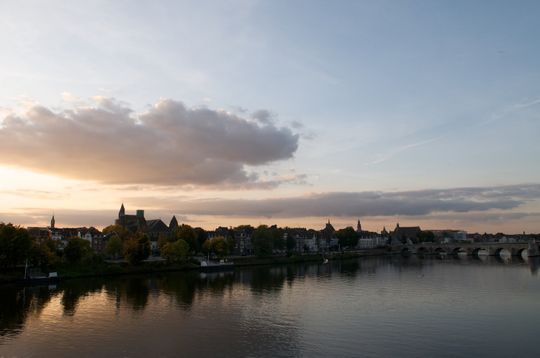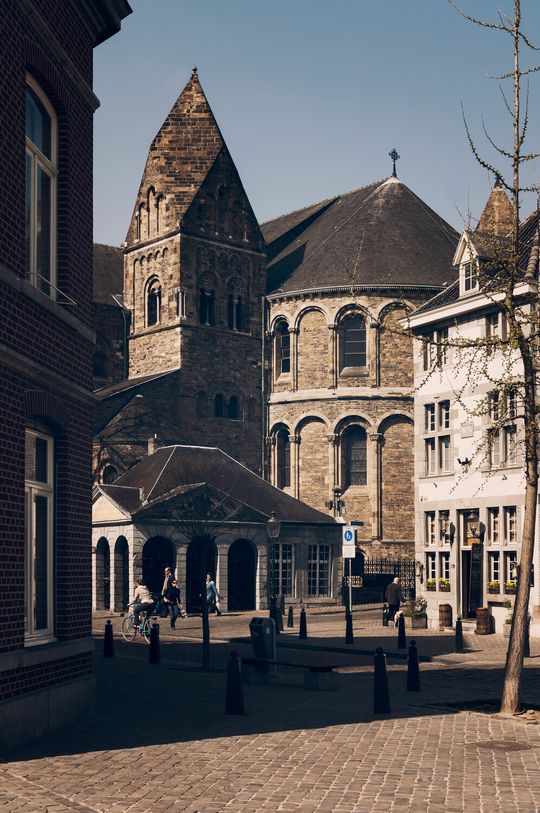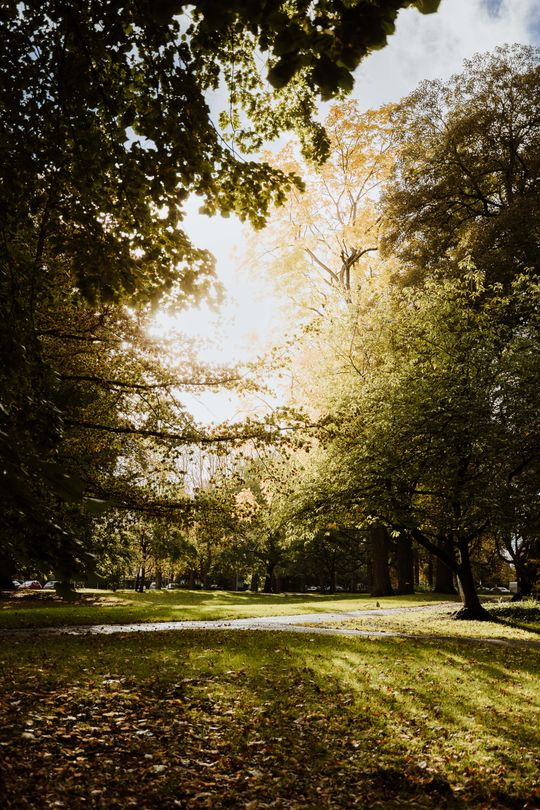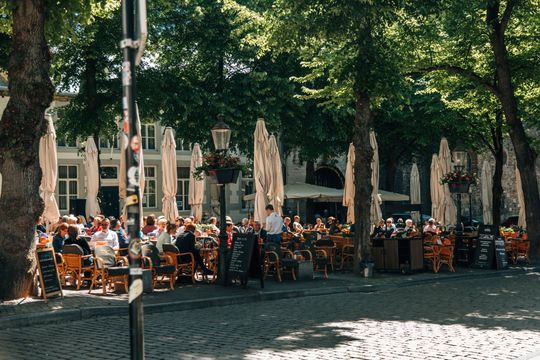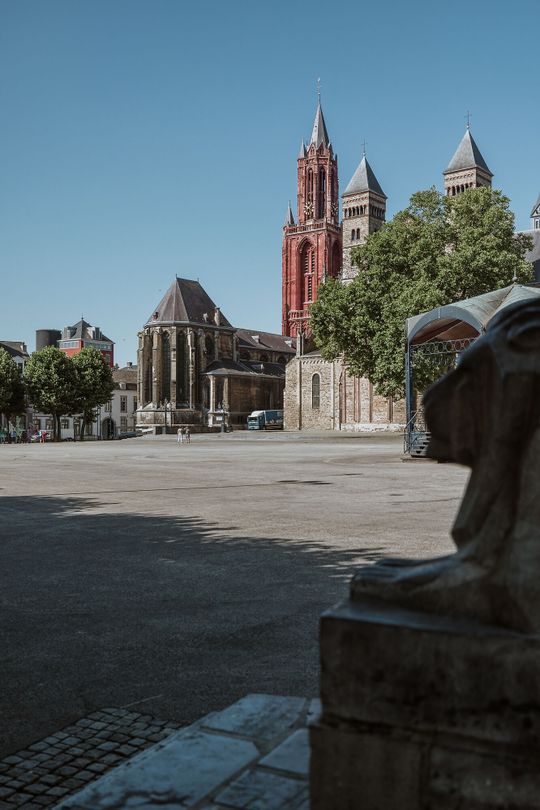King's Day Maastricht 2022 route
We have so many sights, sounds, and scents that we want to show the Royal Family during their visit to Maastricht, so the Royal Family's walking route for 27 April will feature the best that Maastricht has to offer.
This includes the feeling of living in a city that is at the heart of Europe, where historical highlight…
We have so many sights, sounds, and scents that we want to show the Royal Family during their visit to Maastricht, so the Royal Family's walking route for 27 April will feature the best that Maastricht has to offer.
This includes the feeling of living in a city that is at the heart of Europe, where historical highlights and trendy hotspots intermingle. It will also include the scents typical of the city – whether you're strolling through the narrow streets or crossing terraces and squares. We also want to show that people in Maastricht don't rush but instead choose to take our time to enjoy ourselves. This is because Maastricht people believe in the value of the good life, and we welcome both domestic and international guests and students to share it with us. As we have so much that we want the Royal Family to see, taste, or listen to during their King's Day 2022 visit, the Royal Family's walking route for 27 April will feature the best sights, sounds, and scents that Maastricht has to offer. In addition to a number of historic and contemporary hotspots, the route is full of local and royal facts that you may not yet know.
Sights on this route
6221 ES Maastricht
St Servatius Bridge (Sint Servaasbrug)
Sint-Servaasbrug6221 ES Maastricht
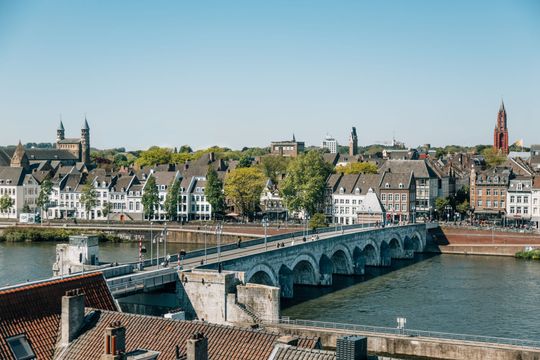
6211 LE Maastricht
Directions
6221 ES Maastricht
- Sint Servaasbrug
- The Sint Servaasbrug (St Servatius Bridge) is also called the 'Aw Brögk' (Old Bridge) in Maastricht dialect. The bridge bears its name for a reason, because it is the oldest bridge in the Netherlands that is still standing (1289).
- In 1895, Queen Wilhelmina was also welcomed on the Sint Servaasbrug during her visit to Maastricht. A veritable city gate was built to welcome her. If you turn 90 degrees to the right, you will see the Wilhelminabrug (Wilhelmina Bridge), also known as the ‘Nuij Brögk’ (New Bridge) in Maastricht dialect.
- In 1925, Queen Wilhelmina and Princess Juliana came to Maastricht because of work on the Julianakanaal, a channel providing a bypass of the Maas. Juliana was 16 years old back then. She was offered a silver shovel, which she was the first to put into the soil. She liked the shovel so much that she smiled and offered to finish the whole job in one go. –
- The Royal Route starts exactly in the middle of the city, between Wyck and the city centre of Maastricht. And above all: on the bridge that connects the banks of the Maas. As a former 'Prince of Waters', King Willem-Alexander will undoubtedly feel at home here.
- Mestrechter Geis
- A touch of charm and playfulness with a good dose of humour and joie de vivre. We are talking about a true bon vivant. That's how you could describe the 'Mestrechter Geis', or the mind and spirit of Maastricht residents. The bronze statue on the Houtmaas by artist Mari Andriessen represents the spirit of Maastricht.
- Back in the days, people tried to avoid this place. It was dark, poor and dodgy. Things have changed since then. Stokstraatkwartier is now known as a luxurious and exclusive shopping area. Until the early 1970s it was a socially deprived working-class district. It had a dubious reputation for the number of "guesthouses" (which would serve as brothels).
- Roman Bridge Monument
While walking from the Houtmaas along the banks of the Maas, you will see the monument of the roman bridge in the water. It is reminiscent of the first Roman bridge over the Maas that could be found here before the Sint Servaasbrug was built.
- Het Bat
- Batteroaf
'Batteraof' is a typical Maastricht word. In Maastricht dialect, the word is used for a mischievous person. The word comes from coal carriers who carried bags of coal from the quay into the city via Het Bat. Some of the coal powder would leak out of their bags and the carriers would get covered in coal dust. It made them look like black ravens (‘raof’ means ‘raven’).
- If you walk from the Sint Servaasbrug towards the Stadspark (City Park) via Het Bat, you will pass a small cross street on the left: the Eksterstraat. Together with the Plankstraat (a little further ahead), it is the oldest street in Maastricht. Eksterstraat and Plankstraat were connecting streets between the east and west gates of the Roman Castellum, built around 333.
- Graanmarkt
- Memorial trees
A Maastricht tradition: In the past 100 years, about 8 different memorial trees have been planted for the births of princesses and throne changes, for example. You can find a memorial tree at the terrace of café La Bonne Femme at Graanmarkt: the Willem Alexander tree that was planted in honour of his birth in 1967. A little further in the city park near the wooden bridge over the Jeker, the Koningsboom (King’s Tree) can be found. It was planted in 2013 in honour of the throne change. You can recognise it by the shiny silver King's Gate.
- Stadspark (City Park)
- Maastricht and the Dutch National Anthem
Maastricht's past as a fortified city is clearly visible in the Stadspark. The city wall and the cannons in the park are reminiscent of the confrontations and battles that took place here, for example during the 80-year war and the Dutch Revolt. Due to the strategically advantageous location of Maastricht, the city occupied a prominent position at the time. That’s why Maastricht is the only city in the Netherlands that is mentioned in the Dutch National Anthem. Just listen – it’s in the 11th verse!
- If you walk along the Maas towards the Stadspark (City Park), you will have a beautiful view of the skyline of the architectural Céramique district on the other riverbank. The striking Bonnefantenmuseum by architect Aldo Rossi and the Limburg Provincial House by architect Gerard Snelders will perhaps be the most eye-catching.
- Did you know that Limburg is the only province in the Netherlands where people unofficially call the King's Commissioner the gouverneur, and the Provincial House the gouvernement? The difference is caused by the fact that Limburg only became part of Dutch territory in 1866. In the Duchy of Limburg (1839-1866) to which it belonged earlier, people spoke of a gouverneur. Until the French Revolution, Maastricht had a military gouverneur der vesting, the highest representative of the Republic in Maastricht. He then lived in the gouvernement on Bouillonstraat.
- The Provincial House, also known as the gouvernement in Limburg, is not only the place where Limburg politics is conducted. It is also the place where the Maastricht Treaty was signed on 7 February 1992. The building also functions as a 'home' in Limburg for the royal family. The members of the royal family regularly stay in the Provincial House on special occasions. For example, it was Princess Beatrix who officially opened the Provincial House in 1986. His Majesty King Willem-Alexander and Her Majesty Queen Máxima also started their visit to Limburg here on 12 June 2013 after the enthronement on 30 April earlier that year. Did you know that the Provincial House even has a special King's Chamber that is used during the visits? You can learn all about it during a tour of the gouvernement.
- Maastricht is the only city in the Netherlands that is mentioned in the Dutch National Anthem. The 11th verse refers to the 80-year war and the Dutch Revolt.
- Cobblestones: they look amazing, but they are a nightmare if you like high heels. Nevertheless, we are happy to accept the characteristic cobblestones as they are. After all, looks are important too, and the cobblestones fit perfectly with the typical Maastricht tread. We don't rush here. We like to stroll and enjoy and take our time doing so. Shopping, going out for drinks and extensive dining are simply most fun if you take your time.
- Onze Lieve Vrouweplein
- Just before reaching Onze Lieve Vrouwenplein, you will walk past a passage with the name Hondertmarck (‘a hundred marks’) written above it. It refers to a former nunnery that was located here. If you wanted to join the nunnery as a nun back then, your parents were charged 100 gold marks.
- Maastricht has several squares, which is quite exceptional. Most cities in the Netherlands only have one central market square. The difference can be explained as follows. The construction of the second city wall started when the population was still growing. However, the plague broke out before the second wall was finished, causing the population to shrink. Suddenly there was a lot of remaining, undeveloped space within the city walls. The undeveloped areas became squares. Which is no problem at all, of course – we know how to handle that in Maastricht. After all, these squares are now vibrant places with cozy terraces and events.
- Every and every year, hundreds of people come to the chapel of the Onze Lieve Vrouwekerk (Church of Our Lady) to light a candle, day in and day out. You will find its entrance on the square. Lighting a candle in the chapel is a tradition for many locals, and many visitors like to visit the chapel to light a candle as well. To celebrate, commemorate or simply for a moment of silence. The bright flames make for an impressive sight.
- The headquarters of the European Institute for Public Affairs (EIPA) can be found at Onze Lieve Vrouweplein, where Studio Europa is also located. The courtyard of the building is not only a place where the “spirit of Europe” can be experienced. If you look closely, you will see the Onze Lieve Vrouwekerk (Church of Our Lady) reflected in the building. This must have been the architect's intention, right?
- A swimming pool was supposed to be built in the basement of the five-star Derlon Hotel. However, while digging, renovation workers came across the remains of an ancient Roman bathhouse. The swimming pool was never realised, but a museum basement was built instead. The museum is freely accessible to everyone.
- Virgin Mary statues on the corner of Onze Lieve Vrouwenplein and Bredestraat
On the road from the Onze Lieve Vrouwekerk to the Sint-Servaasbasiliek – also known as the bidweg (prayer road) – you will come across several statues of the Virgin Mary that have been 'hidden' in the facades. The statues were gifted by people on the prayer road who wanted to show their gratitude for the help that Mary had offered them.
- Street names in Maastricht
Do you want to learn some Maastricht dialect words as a visitor? Take a look at the street signs on and around Onze Lieve Vrouweplein. The signs list the street names in 2 languages.
- Purveyors to the Court
In the area around Onze Lieve Vrouweplein, within a radius of about 100 metres, you will come across no fewer than 4 businesses that bear the title ‘Purveyor to the Court’: flower shop Frissen-Pieters (Graanmarkt), men's fashion shop Maison Louis (Stokstraat), hair salon Craft (Onze Lieve Vrouweplein) and coffee and tea roastery Blanche Dael (Wolfstraat).
- Vrijthof
- Memorial stones
Close to number 37 of Bredestraat you can see one of the many memorial stones that have been incorporated in many Maastricht pavements. The stones are a reminder of the Maastricht residents that were deported and murdered by the Nazis during World War II.
- Spanish Government
The Spanish Government is said to be one of the oldest surviving residential buildings in Maastricht. At the time, the house was the first building to be part of the immunity area of the Sint Servaasbasiliek (Basilica of Saint Servatius) hence the name Prima Porta. In the 16th century it served as a (royal) residence for various dukes from Brabant, Emperor Charles V, and later also for King Phillips II of Spain (hence the name). Nowadays you will find the Photo Museum at Vrijthof in the historic building.
- Red
Why is the Sint Janskerk (Saint John's Church) red? It’s a frequently asked question. There are all kinds of theories. Some say it’s oxblood, but “oxblood red” is simply what the paint colour is named. The colour was once used to mark the buildings that belonged to the Sint Servaasbasiliek (which once had the same colour). It also protects the structure against damage from acid rain and covers the colour differences between the types of marl after renovation work. The colour red is, in addition to ochre and white, one of the three historic colours that were allowed to be used for facades in Maastricht.
- Zate Hermenie
The artwork Zate Hermenie (Maastricht Dialect for ‘tipsy brass band’) at Vrijthof can be described as a joyful ensemble giving colour to the city. And that’s exactly what a traditional zate hermenie in Maastricht does during Carnival: giving Maastricht colour. A traditional zate hermenie is a brass band with both young and old, non-professional musicians. The non-professional aspect is important: the less perfect the notes, the bigger the chaos and the more you can speak of a real zate hermenie.
- Café in the Oude Vogelstruys
Café in the Oude Vogelstruys, also known as 'De Struys', is often referred to as the oldest café in Maastricht. The site has had a catering function since the early 14th century, when it was an inn for itinerant pilgrims. The name refers to the ostrich eggs that are part of the relics of Saint Servatius. The eggs attracted a lot of interest at the time.
- Hoofdwacht
The Hoofdwacht at Vrijthof used to be the headquarters of the garrison commander, where the most important people of the army worked. The keys to the city gates and other settlements were stored and guarded at the Hoofdwacht at night. Fun fact: opposite the main guard you will find cafe de Momus, recognisable by the fool's head at the top of the facade. The Momus society used to be located here. According to legend, the fool's head could look right inside the garrison commander's office in the Hoofdwacht – a silent protest against Maastricht joining the Netherlands at the time.
- Theater aan het Vrijthof
The Witte Vrouwenklooster (White Women’s Monastery) once stood on this site. It’s a place that appears in the famous play about Mariken van Nieumeghen, written around 1500. Mariken is said to have stayed at the monastery as atonement for a sinful life and eventually died there. The building of the monastery was later replaced by a new building that was used as a general's house. Before the Theatre moved into the building, it was used as a municipal museum, the municipal receiver, the city archive, city library and police station.
- Perroen
The ‘real’ Perroen is not to be confused with the cafe bearing the same name that is also located at Vrijthof. The Perroen is the stone column on a plateau with steps – it is surrounded by three lion figures. It was erected in 1292, symbolising the authority of the Prince-Bishop of Liège. At the time it was used as a central spot for making announcements. Convictions and witch burnings also took place here. Nowadays it is a nice place to sit, hang out and eat ice cream while you enjoy your view over the square.
6211 LE Maastricht


